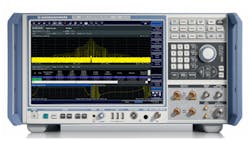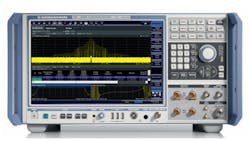Analyzer, Thread Certification Program, Meet Test Challenges Head On
Early last week I listed what I see to be five of the leading trends and challenges in test, The gallery was barely up when I got word on two solutions that fall into two of these areas: 5G and Embedded Test.
The 5G solution came in the form of a new analyzer from Rohde & Schwarz, and Embedded Test in the form of access to paupers to the Thread spec’s virtual test harness and certification program from the Thread Group. The harness was announced as part of the official launch of its mesh IP-based home automation specification on July 14.
The analyzer is the FSW85 high-performance FSW85 85-GHz signal and spectrum analyzer (pictured above). This would have been good to add to the solutions portion of the 5G test trends and challenges slide as it has a bandwidth of 2 GHz, low phase noise down to -137 dBc at 10 kHz offset, and a dynamic range of 88 dBc (with noise cancellation).
So armed, the analyzer can accurately measure wideband-modulated or frequency-agile signals, and do so simultaneously across multiple interface standards, such as GSM, CDMA2000, WCDMA/HSPA/HSPA+, and LTE. Typically, this analysis would have had to be done using a separate analyzer for each standard.
The ability to analyze multiple standards simultaneously is a critical interim step toward 5G, where many interfaces will have to interoperate before we move to a new architecture that we hope will be defined in the next two years and emerge by 2020.
Thread Spec Goes Live
The much-anticipated Thread specification officially launched last week to much ado, and rightfully so, as it forms a critical component of the drive to provide a low-power, IP-based, wireless mesh interface on a standard physical-layer radio. In this case IEEE 802.15.4, the same radio as ZigBee. In speaking with Skip Ashton, vice president of software engineering at Silicon Labs, and chief technology officer with the Thread Group, it quickly became clear that Thread will close the home automation gap between Bluetooth and Wi-Fi by providing that combination of low-power mesh networking and IP addressing, as well as high security and ease of device commissioning, all critical factors for the Internet of Things (IoT).
At the same time as it announced the spec, the group announced that Qualcomm was to be a board member of the Group and that Tom Sciorilli would lead the Thread certification program that is to start in September. Qualcomm adds significant weight, while Sciorilli’s role shows the seriousness and momentum of the Group.
However, a certification program is only good if designers can test interoperability. Unfortunately, the virtual test harness is only accessible to contributing members of the Thread Group, who pay dues of $15K.
This isn’t good news, as many designs for the IoT and home automation are now coming from small startups that can’t afford the rent, never mind the $15K it costs to become a contributing member.
I put this to Chris Boross, president of the Thread Group, and he mentioned an innovation enablement program the Thread Group has initiated, giving free membership for select startups, and then provides help to those startups to get them off the ground, successfully.
This doesn’t help all the other thousands of startups, but if you have a good idea, the Group is about to select the second-quarter winner. The Q1 winner was Ubiant: apply now and you may be the second recipient.
I really mean apply now. Chris said they literally are selecting in the next week or two, once the dust settles on the spec announcement.
And for those of you wondering, there’s a story behind why I chose Test.Pass as the name for this blog, but that’ll have to wait for a quiet week. Stay tuned.
About the Author
Patrick Mannion Blog
Founder and Managing Director
Patrick Mannion is Founder and Managing Director of ClariTek, LLC, a high-tech editorial services company. After graduating with a National Diploma in Electronic Engineering from the Dundalk Institute of Technology, he worked for three years in the industry before starting a career in b2b media and events. He has been covering the engineering, technology, design, and the electronics industry for 25 years. His various roles included Components and Communications Editor at Electronic Design and more recently Brand Director for UBM's Electronics media, including EDN, EETimes, Embedded.com, and TechOnline.

